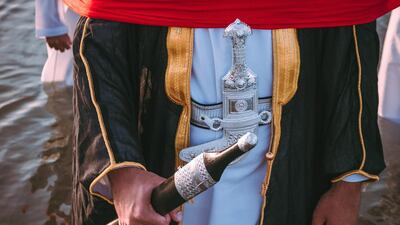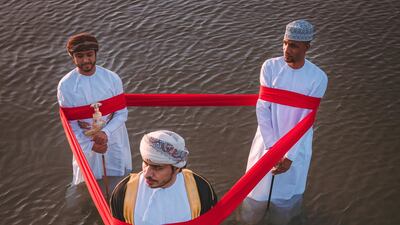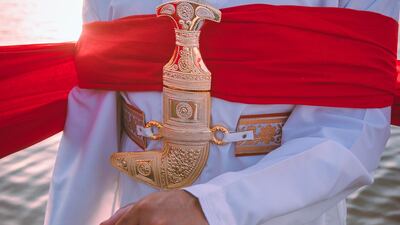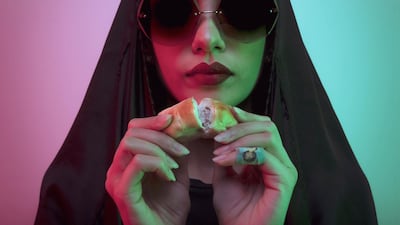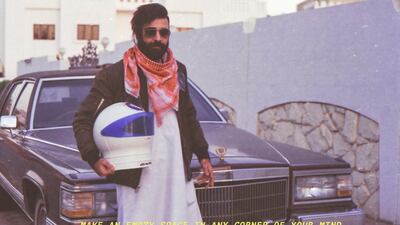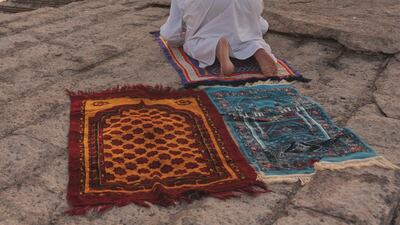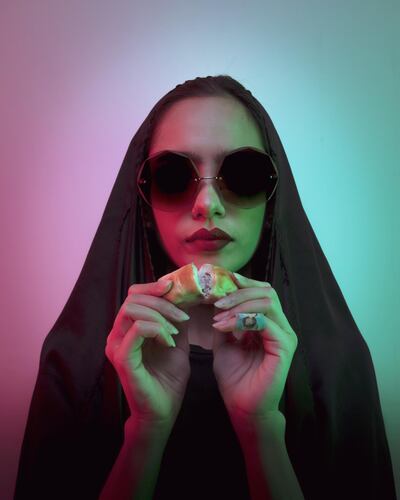In a series of vivid, gripping images by Muscat photographer Mahmood Al Zadjali, a young Omani groom stands up to his knees in the sea, looking all the world like an Arab King Canute, powerless to hold back the tide.
But unlike the 10th-century monarch, Al Zadjali’s stoic, khanjar-wearing groom – flanked by two inscrutable groomsmen – stands with his arms bound tightly to his sides with bright red cloth, a traditional wedding symbol that here takes on a new meaning.
"The red ribbon in my photography is a metaphor for society's expectations," Al Zadjali, 25, tells The National, "while the ocean is a tidal wave of costs".
Lavish wedding celebrations can saddle young Omanis with significant debt as they start out on married life.
In 2013, the country's Shura Council recommended a 4,000 riyal (Dh38,200) payment so lower-income Omanis could afford to get married.
“Society expects certain things from men who want to get married,” Al Zadjali says. “Gold, jewellery, an incredible wedding dress, but I know how much it depends from a family to another.
“These expectations form a circle that we have to enter. Some people struggle with the societal expectations and get burdened by overwhelming financial costs which drown out that happy wedding day they were looking forward to.”
With weddings costing about 12,000 Omani riyals only a few years ago it is clear that At What Cost – painstakingly shot in what Al Zadjali calls "absolutely exhausting" June temperatures – comes at an opportune time.
Al Zadjali, who also works as a documentarian and filmmaker, said he was “happy to see so many people discussing the issue and normalising it”.
“I saw people talking about what sacrifices they’re willing to make, to make marriage more accessible for a partner they want to spend their lives with, which is wonderful.
“However, unfortunately I also noticed a subset of people turning it into a ‘blame game’. I saw some women saying that men are more willing to spend money buying cars than for marriage. I also saw some men turning bitter about the financial expenses, blaming their future brides for the costs.”
At What Cost ties in with themes of freedom and transformation that underlie Al Zadjali's work, which often casts an analytic eye over Omani culture and society.
“I think it’s fair to say that the more closely knit a society is, the more of an influence other people appear to have on you,” Al Zadjali says. “This has its plus sides, and it also feels restrictive in other cases.
“I really like to highlight this idea of ‘what people want’ and the triumphs of personal choice when society gives people an option to do as they want, as well as how sometimes you feel like your choices have been influenced by others.
“Consider the red ribbon in this shoot, for example. That ribbon is purely created from a well-meaning society that just wants you to have a beautiful wedding, but it can tie you down financially.”
Although At What Cost and the conversation it has sparked are rooted in the culture and traditions of Oman, Al Zadjali's visual art often casts the sultanate in a new light. In More Precious Than Gold series, garish colour illuminates a hijab-wearing woman in a modern, visual reflection upon food and Ramadan. Last year's Arab Spaceman series – shot with retro 35mm film – features a raffish keffiyeh and kandura-wearing man carrying a space helmet, with cryptic subtitles.
Al Zadjali’s enthusiasm for his Olympus OM-1 camera and its 35mm film – which gives his subjects and Muscat a grainy, washed-out look – is rooted in what he calls the “raw aspect” of it.
“In a 35mm film camera there are no computer aids and chips to help you along, and you never get to see your photos until you’re done developing them,” he says. “Sure, this means difficulties along the process, but I just love the concept of this equipment. Once you start using one, it’s so hard to go back to modern methods. And the end result could never be reproduced by digital cameras.”
This intriguing mix of very Khaleeji visual imagery – often executed with knowingly vintage techniques and an eye for 21st-century themes and issues – makes for arresting imagery. Al Zadjali’s work, influenced by Australian photographer, musician and producer Regan Mathews, also known as Ta-Ku, sits comfortably alongside other Omani photographers such as Hussain Al Amri, Meyyan Al Said and Shamsa Bint Hamed Al Harthi.
“I’m an Omani to my very core at the end of the day,” Al Zadjali says. “So, I usually tackle ideas that relate to me and the world around me even while trying to address the stories of all people.
“It’s important as a creator to understand that at the end of the day, we all have a limited view of the world. Nobody can capture the whole world in a photo, so we tell stories that relate to us somehow.”
Al Zadjali is currently working on a new documentary short, but is coy about revealing the subject matter. If it is anything like his previous work, his interest in people and their stories will be at the heart of it.
“All of my stories revolve around people and how they interact with the world around them,” he says. “It’s essential to have a human or emotional aspect, and I love to explore how human beings live and breathe the world.”
Or, as his Arab Spaceman might say: "There is no such thing as an empty space or an empty time. There is always something to see."
